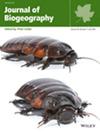A Geological Imprint on Plant Biodiversity: Eastern Australia's Cenozoic Volcanic Flora
Abstract
Aim
Australia's distinct geological history provides key insights into the diversity of its flora. While previous studies have predominantly focused on climate as the main driver of species richness, growing evidence suggests that geological factors also play an important role. This study aims to investigate the influence of Cenozoic volcanic lithologies on terrestrial vascular plant diversity in eastern Australia, disentangling the relative contributions of climate and geology to biodiversity patterns.
Location
Eastern Australia.
Taxon
Terrestrial vascular plants.
Methods
We assessed the patterns of species richness in this region by examining whether sites with Cenozoic volcanic lithologies harbour greater vascular plant diversity, using a permutational multivariate analysis of variance (PERMANOVA). We then used a supervised machine learning algorithm (decision trees) coupled with partial canonical correspondence analysis (CCA) to discriminate the environmental variables influencing species richness and site composition in 230 sites in Queensland, New South Wales, Victoria and Tasmania.
Results
Soil profile variability and terrain ruggedness, influenced by underlying volcanic lithologies, emerged as primary predictors of species richness. We found species composition, indicative of distinct ecological communities, showed greater similarity within lithological types and varied significantly across volcanic complexes at different latitudes. Notably, areas of higher species richness corresponded with a greater diversity of stratigraphic units within protected zones.
Main Conclusions
Our study reveals a significant imprint of Cenozoic volcanic activity on present-day plant species richness and distribution in eastern Australia. We show that geological features, particularly lithology and site complexity, play a crucial role in shaping species richness beyond previously recognised climatic factors. These findings highlight the importance of integrating geological and edaphic factors into conservation strategies, thereby broadening our understanding of ecological dynamics, and guiding more effective biodiversity conservation.

 求助内容:
求助内容: 应助结果提醒方式:
应助结果提醒方式:


